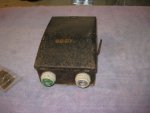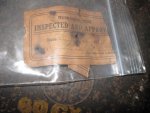Note the open rectangular cutout in the sheet metal of the top of the box. In my experience, this was for the electric meter to settle on, and allowed the conductors to and from the meter to pass.
I'll bet that this is a PoCo approved Service Center, may even have been supplied by the PoCo with the meter. The Safety Switch lever handle, allowing the occupant to operate the disconnect without opening the enclosure, offered the same additional safety for personnel that the bottom, exterior fuse holders would also supply.
I regret that I don't have a photo, but I removed a dwelling single branch circuit 30 Amp 120 Volt service center, manufactured by Square D, that was quite similar. At the time I removed it, for a service relocation and upgrade, it was still in service with the PoCo meter present. It had a deadfront that allowed the replacement of the Edison fuse without opening the wire containing enclosure.




